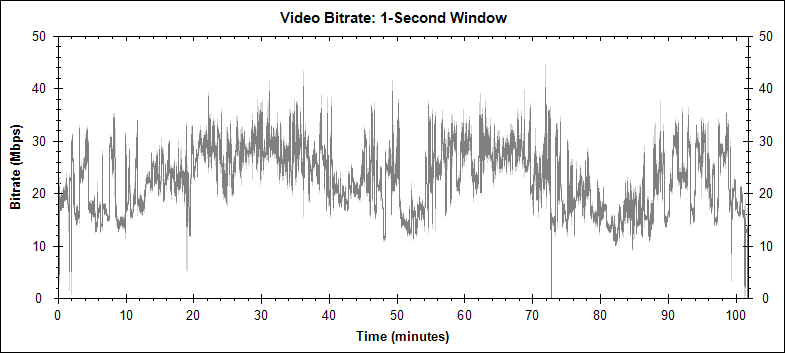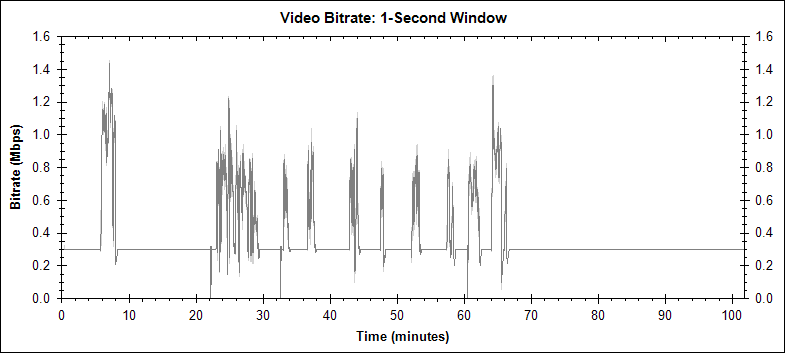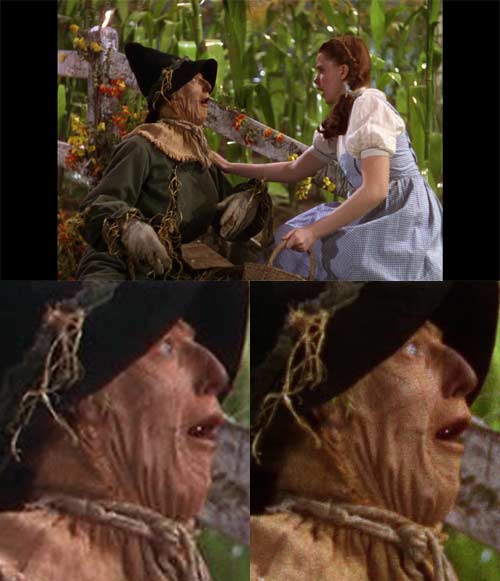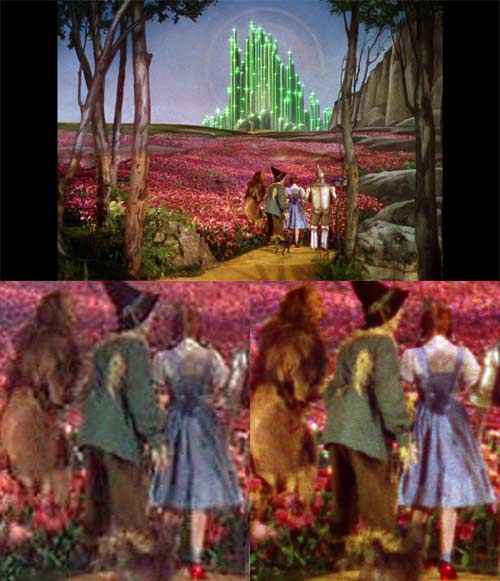 Picture:
Picture:  Sound:
Sound:  Extras:
Extras: 

Movie:  Picture:
Picture:  Sound:
Sound:  Extras:
Extras: 
The picture quality is extraordinary. Beautiful, in fact. The only criticisms I could possible make is that there is occasionally a tiny bit of frame jitter, in which the framing jiggles around slightly (just a pixel or two), and particularly in the sepia parts there is occasionally a little brightness variation.
But the sepia parts are actually shot rather differently, more artistically in fact, than the colour central section of the film. The 3 strip Technicolor camera was so bulky that inventive camera placement and fluid movement was very difficult to achieve, especially as the film had an ASA rating of just 10, requiring enormously hot lighting to deliver any kind of respectable depth of field and shutter speed.
As far as the sound went, the voices were clean and there was no noticable hiss, dropouts or optical scratches but the music consistently had that pinched 'old movie' sound. I figured that once again we had the 'Academy Curve', so I recorded the brief orchestral overture which plays during the opening titles. Looking at the resulting frequency balance graph, it was as though a hard bandpass filter had been applied, with the end points set at 50 and 6,000 hertz. Basically there was no usable audio content above 7kHz.
The main audio is presented in Dolby True 5.1. Warner Bros seems to have managed to apply a little spread so that the sound doesn't seem to come from just one point, and fed a tiny bit of reverb into the back channels. This has been done tastefully so it is not at all intrusive. But if you prefer you can listen to the original mono audio (cleaned of hiss and crackles). This isn't provided in the audio menu, but as a special extra, and comes in the form of a Dolby Digital 1.0 audio track at 192kbps. This has a very similar frequency spectrum, except that the bottom end hits a brick wall at 70 hertz.
There is a Singalong feature with progressively highlighted song lyrics over the movie. This is implemented as a BonusView PIP item, and it won't work with early Blu-ray players. With this edition you get a booklet, 'collectibles' and a second disc with lots of SD extras. The best of these are six previous cinema versions of the Wizard's story, filmed between 1910 and 1933, one from 1914 directed by L. Frank Baum himself! The worst would be the 1990 TV movie biopic about Baum, with quality that looks like a transfer from VHS.
Web addition: Note that on the second disc you get half a dozen early cinematic Wizard of Oz interpretations, including one directed by the books' author, L. Frank Baum himself, plus a 1990 made-for-TV biopic on Baum:
 (Australian rating); Region Free
(Australian rating); Region Free
The following video bitrate graph was generated by BDInfo 0.5.3:

The following graph is for the BonusView PIP, which shows where the song lyrics occur. Not so much singing in the later parts of the movie:

In the following examples, at the top of each is the full frame (suitably shrunk down) used in the comparison, with a 250 pixel wide detail from the frame underneath. The left side is from the PAL DVD. The image was captured digitally from the disc (using VideoReDo Plus), scaled up from its native 720 by 576 resolution to 768 by 576 (to present in the 4:3 aspect ratio) by the application. Then, in order to be comparable to the Blu-ray version, I scaled it from that to 1,440 by 1,080 in Photoshop. The detail is from that last scaled version, and has not been rescaled again. The right side is from the Australian Blu-ray (captured using the command-line media player MPplayer). This has not been scaled at all.
Since different applications were used to capture the two frames, I am not normally comfortable comparing the brightness or colour between the two. For those visitors from NTSC lands, generally PAL DVDs are just a touch sharper than NTSC DVDs.
In the comparison, the clear difference is the large amounts of MPEG2 compression noise around the text and graphics of the DVD version, and the lack of same on the Blu-ray version. You will note that in the full frame at the top, the Blu-ray version doesn't occupy the full frame height. I am not sure why this is the case. It may have been done in the remaster, or it may properly represent the original framing (which may have been intentionally scaled down to ensure that edge details weren't lost from the credits during movie exhibition). Once the movie proper starts, the full height of the frame is occupied:

The increased resolution of Blu-ray allows the check on the Dorothy's dress to be resolved, unlike the DVD:

Now that we're into the colour section of the movie -- shot in proper three strip Technicolor -- Dorothy's dottiness is far more apparent on Blu-ray than DVD. Despite this (and it is far less apparent in motion on the screen), she is more cleanly defined on the Blu-ray:

In this more frenetic scene, the theme of grain continues, but the relative absence of compression noise and the slightly greater detail allows a much more coherent picture overall:

Look, we're talking about a very old movie here. The film resolution, especially in Technicolor with its need to align three separate strips, and super low speed, would appear to be not much more than PAL DVD has to offer, and seemingly less than Blu-ray has to offer. So there isn't a hugely sharp appearance of the kind you see with recent movies. Nonetheless, in addition to reducing confusing-to-the-eye MPEG2 compression noise (while revealing far easier to tolerate grain), the Blu-ray still yields useful extra detail. For example, see the scar-like stitches on the scarecrow's face. Later there are even flashes of weave in his face mask:

Finally, in this one the splotchy MPEG2 compression noise almost overwhelms the characters on the DVD:
